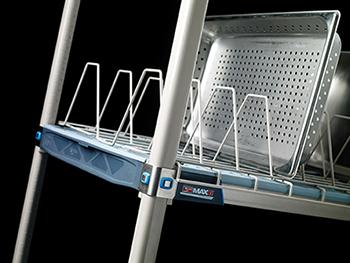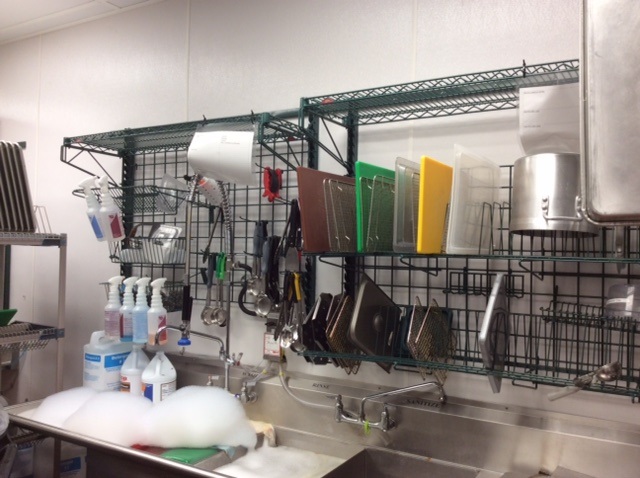Even in the fast pace of a commercial kitchen, keeping things clean is an absolute must to avoid issues like cross-contamination, inherent food-borne illnesses, and other hygiene issues.
Once surfaces, utensils, and containers are thoroughly washed, it's easy to think of them as "safe" - everything from the formula of your cleaning products to the temperature of the rinse water is tuned to do exactly that. If a pan is scrubbed properly with the right kind of soap in the right water temperature, it's good to go for the next round of food prep, right? Not if you're wet nesting those same kitchen pots, steam pans, bun pans, and sheet pans!
Wet nesting is a sanitation pitfall you want to avoid to keep your kitchen operations safe. Keep reading to learn more about wet-nesting and how you can avoid it.

What is Wet Nesting?
It may sound like a new way to raise exotic birds, but wet nesting actually refers to placing two recently washed items together in a nested fashion, preventing proper airflow. Even the most vigorous washing isn't full sanitation, so what might otherwise be harmless - a small particle of food gone airborne from a blender lid, or a pop from a nearby fryer - becomes the beginnings of a big bacterial problem for you and the guests you serve.
In a moist, dark, low-air environment, unseen bacteria grows unchecked, and suddenly that mixing bowl is a biological incident waiting to happen. Even at high temperatures, the food or ingredients you place on that wet-nested kitchen equipment can act as an accidental insulator, or even as fuel for further bacterial growth. The worst part is that you probably won't even be aware a wet nesting issue has ended in disaster until your staff or guests become ill.
How Do I Prevent Wet Nesting?
Keeping wet nesting out of your kitchen is as simple as being vigilant. You wouldn't put a pan back in storage with dried food on it, so make sure you're not doing the same with lingering dampness. A service towel may not remove all traces of water after a wash and can even spread bacteria, which is why FDA ware washing guidelines mandate that all wares must be air-dried.
Of course, busy kitchens can go through a lot of utensils and equipment quickly, leaving limited space for air-drying. Don't be tempted to stack your wet pans. Instead, play it safe and invest in racks and carts that allow air to flow freely between stacked items, and double-check that they're completely dry before nesting them in storage. Metro's SmartWall can also be installed above sinks to utilize underused space for drying utensils, cutting boards, and more.
If you add new dish washing staff to your kitchen team, emphasize the importance of "drying" being a part of "cleaning" - something that, much like proper soap, can't be left out of the equation. If the proper drying equipment is made available, dry-nesting habits are instilled from day one, and they are reinforced on a regular basis, you won't have to worry about your pans becoming an unwitting breeding ground for trouble.
What Equipment Should I Consider?
Your drying equipment is on the front line in the battle to end wet nesting - don't settle for a regular rack.

Your kitchen isn't a regular kitchen. You need drying solutions that are built for high-volume, heavy use in the wash-dry cycle, preferably on wheels for easy movement so that the floor beneath it can also stay clean and dry. Ideally, your choice of rack should also be made of non-porous materials to prevent "soaking up" excess moisture between drying rounds and transferring it to clean pots and pans.
You should also look for equipment made from rust-proof polymers (plastics) that are designed to handle wet environments. The right rack, combined with best practices from your kitchen staff, will ensure that wet nesting never has a chance to darken your proverbial kitchen doorstep.
Avoid Wet Nesting with the Help of Metro
Have you struggled with finding adequate space to dry dishes in your commercial kitchen? Are you guilty of allowing wet nesting to occur because you felt like you had no other choice (don't worry, we won't tell)?
It's time to end wet nesting with smart planning and adequate drying equipment from Metro. Our foodservice solutions are designed to work with your kitchen operations--not against it--creating a more efficient and safe work environment for your staff and customers. Not to mention, it will make the Health Inspector happy.
Ready to optimize your kitchen's sanitation? View our selection of drying racks designed to limit wet-nesting.
